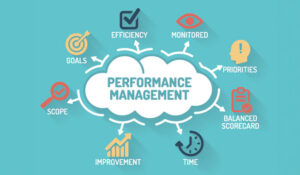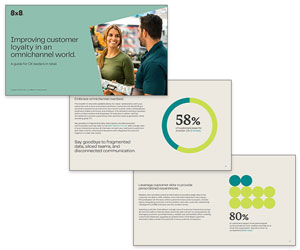We investigate how educating your agents on these five key contact centre metrics can really help to improve agent performance.
First Things First, Agents Need to Know How Their Performance Is Being Assessed
As Justin Robbins, a Contact Centre Expert at 8×8, told us: “Metrics are most effective when we engage employees in the process.”
This statement is particularly true when it comes to metrics that are used to evaluate the performance of contact centre agents.
Why? Well here are three key reasons off the bat:
- Metrics help us to define what good looks like, so we can ensure that agents know what is expected of them.
- When agents know how their performance is being measured, they become more invested in learning how they can improve.
- When everyone is made aware of how performance is measured across the contact centre, the expectations become more consistent from one line manager to the next.
However, there are many more reasons than that, which Justin articulates in the video below.
From this video, we can start to see why agents need to know how metrics like Customer Satisfaction (CSAT), Customer Effort and First Contact Resolution (FCR) work – if these are being used to evaluate their performance.
But not only that, agents need to know what behaviours they can exhibit to better improve these metric results.
With this point in mind, there is probably no metric more important to educate your team on than Quality Scores, and that is where we start our top five list.
1. Quality Scores
In our quality scorecard, we have defined which behaviours agents can exhibit to drive our intended customer and business outcomes.
Agents must therefore have a good understanding of what that scorecard looks like and which behaviours they can personally improve upon.
So, don’t just feedback a quality score to them, really make use of your quality metric by showing agents filled-in scorecards for their calls and, if possible, giving them a copy of the call recording – in case they have forgotten the call.
Also, we need to make sure that all other performance reviews are linked back to what we include within our quality scorecard – which is something that contact centres often get wrong, according to Justin.

“Annual performance reviews, which are often defined by HR or another department, sometimes contain criteria that often have very little direct connection to what the agent does,” says Justin.
“When this happens, agents can really struggle to figure out what matters most – especially if there is any financial compensation tied to those annual reviews.”
When it comes to assessing agent performance, it is therefore important to ensure that we are setting consistent expectations, so advisors know how best to satisfy customers.
For more tips on using quality scores to improve contact centre performance, read our article: 10 Ideas for Improving Quality Management
2. Customer Feedback Trends
There are lots of ways by which we can gauge whether the agent is doing the right thing, it doesn’t always have to come down to quality scores and traditional metrics.
In fact, while customer feedback isn’t usually channelled into a metric, measuring feedback trends is a great way to help us see if our agents are driving the right customer outcomes.
But why should agents know about customer feedback trends?
For starters, here are three key reasons:
- Agents can shine a light on the problem areas that we uncover by measuring customer feedback trends. They talk to customers all day; they’ll know about this stuff.
- Trends in customer feedback help us to justify changes that we make in the contact centre. Showing agents verbatim feedback can really help you to explain your decision-making.
- Sharing customer feedback trends helps to bring the voice of the customer (VoC) into the contact centre – and adds a customer focus to all contact centre activity.
Also, we should be using customer feedback to help educate advisors on best practice. We can do this by using feedback to pinpoint great conversations, which can be shared around the contact centre as an example of how to navigate certain contacts very well.
3. Schedule Adherence
“At the agent level, assessing performance fundamentally comes down to measuring two things: are they doing the right things and are they where they are supposed to be when they are supposed to be there,” says Justin.
Quality scores and customer feedback trends are good measures of whether agents are doing the right things. Schedule adherence is our key metric for determining whether advisors are in the right place at the right time.
Yet advisors often don’t realize the significance of schedule adherence. They don’t know that being five or ten minutes late in the contact centre has consequences for the customer, in terms of hold time, and for their fellow agents, in terms of having a shorter break in between calls.

This is why it is crucial to educate advisors on the importance of schedule adherence. We can do this by giving power of one training and setting schedule adherence goals.
But we need to be careful when setting adherence targets, as advisors might be late to go for lunch, and therefore to return, because they were helping customers – which is the right thing to do.
To overcome this challenge, our leaders and supervisors need to play the “air-traffic control” role of moving people’s breaks in accordance with who is available right now. Advisors will be on board with this, if they themselves know how schedule adherence works.
To find out more about how to manage adherence in the contact centre, read our article: 8 Ways to Improve Schedule Adherence
4. Service Level
Contact centres measure service level in real time to help leaders understand what is happening on the contact centre floor and how they need to react to that.
In contact centres, service level may also be displayed on wallboards and on agent desktops – even though it is not a good and fair measure of agent performance.
So why do contact centres choose to do this and explain the purpose behind the metric to advisors?
Well, there are three possible reasons:
- If service level is low, that means hold times are high. When an agent sees this, they can mentally prepare to deal with frustrated customers.
- If service level is high and agents have lots of time between calls, this may be their trigger for going through some e-learning activities, in order to make better use of their available time.
- When service level is good, things are generally rosy in the contact centre. When it’s not so good, things go in the opposite direction. Service level therefore makes a good “we’re all in the same boat” kind of measure.
Yet service level isn’t the only non-performance-related metric that is often found on an agent desktop and wallboards. Often, metrics like hold time, abandon rate and longest call waiting are also included.
These metrics can help add context to the service level metric for agents, but they are mostly for the resource planning team.
To find out more on how to best use service level in the contact centre, read our article: How to Calculate Contact Centre Service Level
5. Employee Engagement
Agents want to know that their engagement and well-being is high on your priority list.
By tracking engagement as a metric and letting your team know how you are doing so, you can really help underline that your team’s happiness at work is a primary consideration.
Of course, though, you have to do more than that. You will have to engage with agents and ask them how you can improve engagement, for the benefit of both the customer and the agent experience.
Agents must have a voice in this, as they will be much more likely to buy into your engagement metric and strategy if they feel like they have had a key role in designing your engagement activities.
Just remember the link between engagement and customer experience. Your method for measuring engagement as a metric must consider the impact on the customer. This will help you to understand if your engagement strategy is working for your customers.
For more on measuring employee engagement in the contact centre, read our article: How to Measure Employee Engagement
There Will Be Other Metrics to Talk to Your Team About…
We’ve discussed how we need to educate agents on each of the metrics that we use to evaluate their performance. These will vary from contact centre to contact centre.
But it’s not just these metrics that you may need to talk to agents about. You should also think carefully about those that you are presenting on your agent desktops, dashboards and/or wallboards. Agents should have a basic understanding of all of these metrics too.
The aim should be to give your team full transparency, and a contact centre leader should take on the responsibility of clearly explaining:
- How you are defining success
- How you are measuring it
- What role agents do or don’t play in all of that
- How you are interpreting those results
This isn’t just about setting expectations, it’s also about engaging and training your leadership team of tomorrow, as Justin tells us.
“If I want to develop my people, the best way they can do their job today is to understand how I’m doing mine,” says Justin.
“That is why I find it great when I walk into a call centre and an agent can tell me what all of the colours and thresholds on a wallboard mean – but that’s not normal, which is quite sad because it should be.”
Get Your People Excited About Your Metrics
You might be thinking: “Teaching agents about how all of these metrics work is going to be quite a long and maybe even boring process.” But it doesn’t have to be.
Let’s go back to a point that was made at the start of this article: “Metrics are most effective when we engage employees in the process.”
Yet there are many reasons why our people aren’t more engaged with or excited by our metrics. For example:
- The focus is often on failure, while success is expected
- There is misalignment between metrics and goals
- People are held accountable for the wrong metrics
- They don’t think they have an influence on the metrics, or understand why it matters or how it’s measured
So, if you are just getting started in your process of teaching agents about metrics, maybe the place to start is by removing each of these barriers. With these out of the way, you will find it much easier to engage agents with the metrics listed above.
But Don’t Fall Into This Classic Metrics Trap
Throughout this article, we have encouraged you to educate agents on the metrics that you use, particularly when it comes to the metrics that you use to evaluate agent performance.
Yet we do first need to be careful that we are evaluating agent performance in the right way.
If your contact centre is assessing agents on Average Handling Time (AHT) and occupancy, there are a few considerations that you need to make before you start a metrics discussion with your team.
Take a look at the video below, where Justin discusses some of the problems that you might run into when using these metrics to evaluate agent performance.
For more on the dangers of using AHT in the contact centre, read our article: Is Reducing Average Handling Time (AHT) a Good Idea?
Key Takeaways
We have four key takeaways for you from this article:
- Re-evaluate how you assess agent performance to ensure that you are using fair metrics and are targeting desirable behaviours
- Remove the blockers that disengage agents from your metrics strategy
- Educate advisors on the metrics you use to measure their performance on and the behaviours they can exhibit to improve their performance results.
- Think about the metrics that you are displaying on agent desktops and wallboards, before taking the time to educate agents on those too.
For more great insights from Justin, take a look at the following articles:
- 30 Tips to Improve Your Call Quality Monitoring
- Contact Centre Benchmarking – How to Get More From Your Metrics
- How to Continuously Improve Contact Centre Performance
Author: Rachael Trickey
Published On: 30th Sep 2020 - Last modified: 5th Dec 2025
Read more about - Hints and Tips, 8x8, Agent Performance, Editor's Picks, Management Strategies, Metrics, Performance Management, Team Management







































